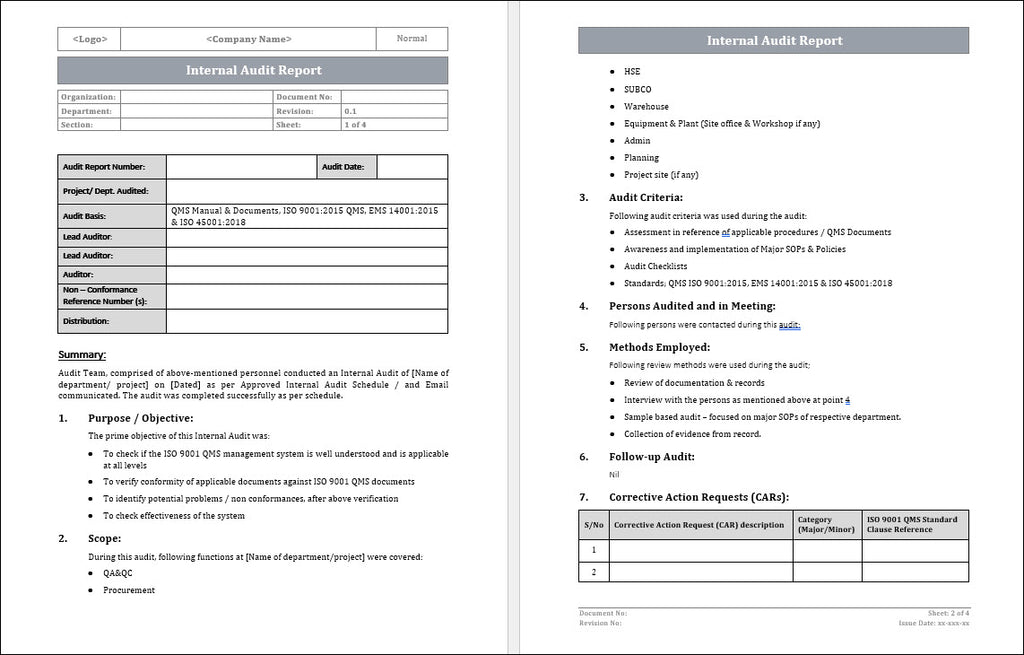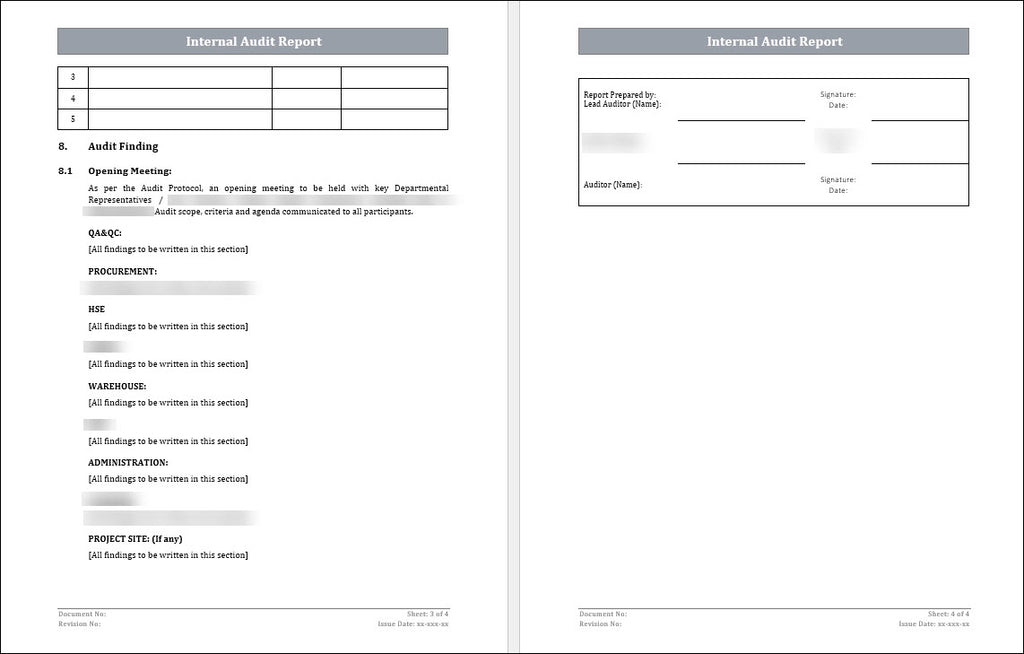ISO 9001 Internal Audit Report Template
Internal audits are an essential component of maintaining quality management systems within organizations. These audits objectively assess the organization's compliance with ISO 9001 standards and identify areas for improvement. The Internal Audit Report plays a crucial role in documenting the findings and recommendations from the audit process. This report serves as a formal record of the audit activities, providing valuable insights into the organization's performance and adherence to ISO 9001 requirements. This blog will explore the significance of the Internal Audit Report in ISO 9001 and discuss best practices for creating an effective report.

Purpose And Scope Of The Internal Audit
The purpose and scope of the internal audit are crucial components of the Internal Audit Report ISO 9001. These elements provide the context for the findings and recommendations presented in the report.
1. Internal Audit And ISO 9001 Compliance: The internal audit aims to assess the organization's compliance with ISO 9001 requirements and identify areas for improvement. It serves as a tool to evaluate the organization's quality management system's effectiveness and ability to meet customer expectations.
2. Documenting The Purpose Of The Audit: When documenting the purpose of the audit in the report, it is important to state the objectives and goals of the audit clearly. This ensures that the readers understand the intent behind the audit and the expected outcomes.
3. Defining The Scope Of The Internal Audit: The scope of the internal audit defines the boundaries within which the audit is conducted. It specifies the departments, processes, and activities included in the audit. By setting clear boundaries, auditors can focus on the area’s most critical to the organization's quality management system.
4. Describing Scope, Exclusions, And Limitations In The Report: The Internal Audit Report should describe the scope, including exclusions or limitations. This allows the readers to understand the extent of the audit and the areas that were not covered.
By clearly outlining the purpose and scope of the internal audit in the report, auditors can provide valuable context to their findings and recommendations. This ensures that the readers understand the objectives of the audit and the extent to which the organization complies with ISO 9001 requirements. The following section will discuss the methodology used in conducting the internal audit. Stay tuned!
Methodology And Approach On Internal Audit
In the Internal Audit Report ISO 9001, the methodology and approach used in conducting the internal audit are pivotal to the accuracy and reliability of the findings. These aspects provide transparency and demonstrate the rigour of the audit. The methodology outlines the systematic process followed during the audit. It includes the methods used to collect and analyze data, such as interviews, document reviews, and observations. The report should document the methodology to clarify and enable others to replicate the audit if necessary. The approach refers to the overall strategy adopted to achieve the audit objectives. It outlines the key steps, including planning, fieldwork, and reporting.
The approach should align with recognized internal audit standards and best practices, ensuring the audit is comprehensive and unbiased. When presenting the methodology and approach in the Internal Audit Report, it is crucial to provide sufficient detail to allow readers to understand the rigorous nature of the audit process. This includes discussing tools or software utilized and any considerations or challenges encountered. Well-defined and transparent methodology and approach in the Internal Audit Report ISO 9001 enhances the credibility and trustworthiness of the findings and recommendations.

The Key Components Of An Internal Audit Report
The Internal Audit Report is a critical document that communicates the results and findings of an internal audit.
1. Audit Criteria: Define the criteria or standards against which the audit was conducted. In the context of ISO 9001, these would be the requirements and elements of the ISO 9001 standard against which the audited processes were assessed.
2. Persons Audited And In Meeting: Specify the individuals or departments audited as part of the internal audit. Also, mention who participated in the audit meeting, which may include representatives from the audited areas and the internal audit team.
3. Methods Employed: Detail the methods and procedures used during the internal audit. This could include sampling methods, interviews, document reviews, and other techniques to gather audit evidence.
4. Corrective Action Requests: Identify any non-conformities or areas for improvement discovered during the audit. Clearly state the corrective actions that are required to address these issues. This section may also include deadlines for implementing corrective actions.
5. Audit Findings: Present the overall findings of the audit, including both positive aspects and areas for improvement. This section should objectively assess the audited processes against the established criteria.
Remember to structure the report in a clear and organized manner. Each component contributes to a comprehensive understanding of the audit process and its outcomes. The report should be factual, concise, and written in a way that is easily understandable by relevant stakeholders.
Recommendations And Action Plan On ISO 9001 Internal Audit
Upon completing the internal audit, the next crucial step is to identify and provide recommendations for any areas of improvement that have been identified. These recommendations should be based on the findings and observations made during the audit process. To ensure the effectiveness of the recommendations, they should be specific, measurable, achievable, realistic, and time-bound (SMART). This will enable management to understand and implement the proposed changes quickly.
In addition to the recommendations, the Internal Audit Report ISO 9001 should include an action plan. This plan should outline the steps that need to be taken to address each recommendation, including the responsibilities and timelines for implementation. The action plan will serve as a roadmap for management to track progress and ensure necessary changes are made. By providing practical recommendations and an actionable plan, the Internal Audit Report ISO 9001 becomes a valuable tool for continuous improvement within the organization.
Conclusion
The internal audit report is a crucial document that provides valuable insights and recommendations for improving ISO 9001 compliance within an organization. Management can effectively communicate and implement the recommendations by following the SMART criteria. The action plan outlined in the report serves as a roadmap for implementing the necessary changes and tracking progress. However, the work does not stop with the report. Monitoring and follow-up are essential to ensure the successful implementation of the recommendations. This entails regularly checking the progress, addressing challenges or obstacles, and providing necessary support and resources.

